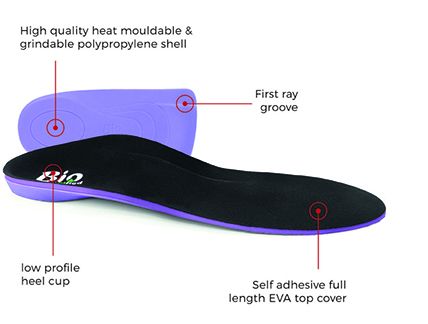The Unified orthotic is designed to incorporate the complete requirements of the vast majority of foot orthoses prescriptions, namely to 1) reduce pronation moments, 2) encourage first ray propulsion and 3) be comfortable!
1) Reducing pronation moments is achieved by applying a force medial to the STJA. The Unified orthotic permits you to do this from many theoretical perspectives. A MOSI modification can be added into the heel cup of the shell for those very pronated patients with a medial deviated STJ axis. Alternatively, a more traditional hemi post or total rearfoot post may be applied, or even a heel raise. Conversely, lateral posting to encourage pronation in the rare supinators can also be added.
2) Adequate first ray propulsion is thought to be perquisite for normal gait. Reducing pronation moments is one method to encourage this, another is to permit first ray plantarflexion. The first ray groove in the shell of the appliance decreases the dorsiflexion moments on the first ray while maintaining a comfortable almost full-width appliance.
3) A lot of patients with very pronated feet often have arch contours that do not fit a prefabricated shell, due to plantar exostoses and pressure points. The material used in the Unified orthotic is heat mouldable, allowing localised heating of the shell and shape change to ensure a comfortable and non-irritating fit.

The type of patient who would benefit from a Unified orthotic includes those with:
- Pronation related symptoms/gait dysfunction, even those with a large amount of pronation and a medial STJ axis requiring a MOSI.
- Supination related symptoms/gait dysfunction.
- Functional limitation of the 1st MTPJ due to either pronation and/or dorsiflexion of the first ray.
Patients who should not be prescribed the Unified orthotic include:
- Stage 2 and above structural hallux limitus. Encouraging the use of the 1st MTPJ in these patients may worsen symptoms.
- Pressure related injury or lesion sub the 1st MTPJ. E.g. ulcers sub the 1st MTPJ.
- Those with possible adverse effects to improved use of the 1st MTPJ in gait, e.g. those with painful limitation to hip extension such a labral tears may extend their hip further in gait with improved 1st MTPJ function.
